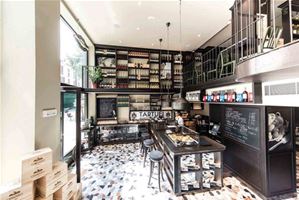The historic Florentine firm Richard Ginori has been synonymous with fine tableware and giftware since its establishment almost three centuries ago. Opened in 1735 by a Florentine marquis, Carlo Ginori, the factory and Richard Ginori brand is still known around the world for its top-quality, elegant handmade dinnerware and porcelain figurines. It predates English bone China production and is an exceptional example of Florentine creativity and artistry. However, the factory, in Sesto Fiorentino, is now at risk of closure. Government officials declared bankruptcy in January. It’s another piece of Florence’s genius loci that may be destined to be lost, even though the tight-knit Richard Ginori factory workers are fighting their hardest to keep it alive, demonstration after demonstration.
On February 20, handfuls of Richard Ginori workers were in Florence’s piazza Duomo, their latest protest of the sorry state of affairs in which the company finds itself. They set up a white tent and a few tables and did what they do best: create. All morning, they decorated plates and made small, extremely elaborate relief plaques and other decorative objects. Most of the approximately 330 Richard Ginori workers were laid off on July 31, 2012, with only a few workers remaining to fill the orders still coming from the company’s biggest export market, Japan. With their fate unknown, many are now asking what will happen to this group of highly skilled artisans and employees if the firm is not rescued from closure.
The employees thought the company’s economic troubles were over on November 14, 2012, when a U.S.–Romanian business consortium saved it from imminent bankruptcy. The new owners agreed to pay 13 million euro to Richard Ginori’s creditors, rehire 280 of the 319 laid-off employees and continue operations. The rescue mission was derailed, however, when a Florence Court preemptively declared the company bankrupt on January 7, 2013.
‘The company will be placed on auction sometime this spring. That’s when we will find out what will happen to us and the factory,’ explained Laura Miliani, who works in the company’s export department. The liquidators now have until mid-May to find a buyer. Unfortunately, however, now that the factory has officially gone bankrupt, the new buyers will no longer have to honor the same terms and conditions that the U.S.–Romanian consortium offered, such as safeguarding the jobs of employees or keeping production in Sesto Fiorentino.
It appears the U.S.–Romanian consortium, comprising the American firm Lenox and the Romanian Apulum (which is, in turn, is under the control of Italian firm, Rodytime), is still interested, but there is also interest from a Chinese firm and the Italian Gruppo Sambonet. ‘I hope the U.S.–Romanian consortium wins the auction; my greatest fear is that the Chinese firm wins and fires us to hire Asian workers that cost less, significantly reducing the quality of the product and leaving us jobless,’ said Elisa Verniani, 26, the ‘youngest at the company,’ she says proudly.
Verniani, a decorator, was one of the three last hires at Richard Ginori three years ago. She completed her studies at the Academia delle Belle Arti of Florence while apprenticing at the porcelain manufacturer, finally graduating last year. ‘The apprenticeship is quite demanding actually, and training can last for years. Many don’t realize how much work goes into making a Richard Ginori product; something as simple as a plate can take hours and hours to complete,’ Verniani explained.
Artistry and local genius: one can say that Richard Ginori made Sesto Fiorentino what it is today and, if it disappears, it will take with it the distinctive identity that has defined the town and its people for centuries. Almost all of the workers come from Sesto Fiorentino and the surrounding area, from towns as close as Doccia and Florence to places further afield like Montelupo Fiorentino and the Chianti area. Thus, the knowledge and skill, or rather ‘the genius,’ are local and are a distinct part of the area’s ‘sense of place.’
Born in Greve in Chianti, Verniani says that her grandfather, who was from Sesto Fiorentino, and those of his generation had a strong bond to the factory: ‘For centuries, the Sestesi gravitated around the factory. It was the heart of Sesto. Just think of the factory’s siren, which rang several times a day and could be heard throughout town. The locals were so used to hearing it, whether they worked for the factory or not, that they regulated their day by the sounding of the siren. In fact, it was strange when the siren stopped ringing last summer.’
This is not true of the younger generations in Sesto, she says, many of whom don’t know much about the factory and prefer to get their stoneware from stores like Ikea, where it costs much less and has a more casual, modern design. ‘I still remember a time when there was a set of Richard Ginori tableware in every home in Florence, even in Italy. I remember when it was customary to give something from Richard Ginori to a newlywed couple. It was a gift that had value and that marked a special moment in one’s life. Sadly, this custom no longer exists among the younger generations.’
Nonetheless, Richard Ginori has retained its prestige in the world, especially in Japan, where demand is still high. But is it enough to keep the Florentine manufacturer afloat? ‘We are the oldest porcelain manufacturer in Italy and most of our products are still made by hand, using the same techniques that were used in 1735. Outside Italy, our most important market is Japan, followed by the United States. There has never been a drop in demand, especially in Italy, despite all of the mismanagement, financial scares and economic crises … After Dafter Maissen in Germany, we are the oldest porcelain makers in Europe and our product is unique; it can’t be made anywhere else but here,’ Miliani affirms.
Aside from the prestige of the product among consumers, there is also a strong sense of pride among the workers themselves in what they do and what their product represents.‘The truth is that once a person starts working at Richard Ginori, a part of the company enters his or her soul. This happens as soon as you walk into the factory and it feels like you’ve stepped back in time, back to the 1700s! Because the factory and they way things are done are exactly the same as they were three centuries ago. The atmosphere is so special that you’d never think it could exist today, instead it does and it’s very rare,’ shares Miliani.
Verniani expresses the same sentiment: ‘I think that when you work for Richard Ginori you belong to a symbol of Florence, you do a job that no one else knows how to do or even knows anything about. It’s a privilege and it’s a great pity to let it die.’
Richard Ginori not only shapes its workers and Sesto Fiorentino, it is also part of the history and identity of Florence. Indeed, Richard Ginori is all around us, Verniani says: ‘Back in the day it used to produce a lot more products, even plaques in terracotta with the names of streets. If you look around Florence, you can still find them. They are now slowly disappearing, but at one point they were everywhere in Florence. Richard Ginori surrounds us, and we don’t even know it.’
Indeed, a distinctive spirit, born in the past, surrounds us in modern Florence. Most times, however, we are not even aware of it until a part of it is gone.
PORCELAIN FIT FOR A SHOWCASE
Richard Ginori 1735 has a dedicated museum in Doccia, the Richard Ginori Doccia Museum (www.museodidoccia.it), and it will also be the focus a new temporary exhibit at Palazzo Pitti this spring. Celebrating the 40th anniversary of the opening of the Porcelain Museum in Palazzo Pitti, the exhibit Luxury and Elegance: French Porcelain at Court and Manifattura Ginori (1800–1830) will run at the Silver Museum (Palazzo Pitti) from March 19 to June 23, 2013, and showcase Ginori porcelain from the Napoleonic occupation of Tuscany to the Lorraine era of the early 1800s. See www.unannoadarte.it for details. Find more information on Richard Ginori 1735 at the corporate site: www.richardginori1735.com







